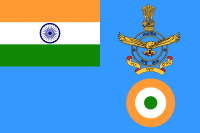Surinder Mehra
Air Chief Marshal Surinder Kumar Mehra (15 November 1932 – 8 December 2003), PVSM, AVSM, VM, was the Chief of Air Staff of Indian Air Force from 1 August 1988 until 31 July 1991.[1] He was born in Delhi.[2]
Air Chief Marshal Surendra Kumar Mehra PVSM, AVSM, VM, ADC | |
|---|---|
| In office 1 August 1988 – 31 July 1991 | |
| President | Ramaswamy Venkataraman |
| Prime Minister | Rajiv Gandhi |
| Preceded by | Denis La Fontaine |
| Succeeded by | Nirmal Chandra Suri |
| Personal details | |
| Born | 15 November 1932 Delhi, India |
| Died | 8 December 2003 (aged 74) Gurgaon, India |
| Alma mater | Modern School Delhi University |
| Awards | |
| Military service | |
| Nickname(s) | Polly |
| Allegiance | |
| Branch/service | |
| Years of service | 1951-1991 |
| Rank | Service Number (4197) |
| Commands | Chief of the Air Staff (India) (1988–1991) South Western Air Command No.28 Squadron No.106 Squadron |
| Battles/wars | Indo-Pakistani War of 1965 Indo-Pakistani War of 1971 Operation Brasstacks |
Early life
He was born in Delhi on 15 November 1932, educated at the Modern School in New Delhi, and thereafter at the Delhi University.
Career
He was commissioned in the Indian Air Force in December 1951 as a fighter pilot.[3]
From 1973-1976 he went on to command the Tactics and Air Combat Development Establishment division, followed by posting as Air Attaché in the Indian Ambassador's Office in Russia. He was awarded AVSM in 1976. After being promoted to the rank of Air Commodore, he assumed command of Adampur and later Jamnagar Air Force stations.[4]
In 1987, he was appointed Air Officer Commanding-in-Chief, South Western Air Command with the responsibility of all air operations in Rajasthan, Gujarat and Maharashtra. In 1988, he took over as the Chief of Air Staff. He retired in 1991. Air Chief Marshal Polly Mehra died on 8 December 2003.
References
- "Surinder Kumar Mehra PVSM, AVSM, VM CAS | Indian Air Force | Government of India". indianairforce.nic.in. Retrieved 28 May 2020.
- Ex-Chief of Indian Air Force
- "Surinder Kumar Mehra PVSM, AVSM, VM CAS". Indian Air Force. Archived from the original on 19 July 2018. Retrieved 15 March 2019.
- Tactics and Air Combat Development Establishment
| Military offices | ||
|---|---|---|
| Preceded by Jayant Ganpat Nadkarni |
Chairman of the Chiefs of Staff Committee 1990–1991 |
Succeeded by Sunith Francis Rodrigues |
| Preceded by Denis La Fontaine |
Chief of the Air Staff (India) 1988–1991 |
Succeeded by Nirmal Chandra Suri |
